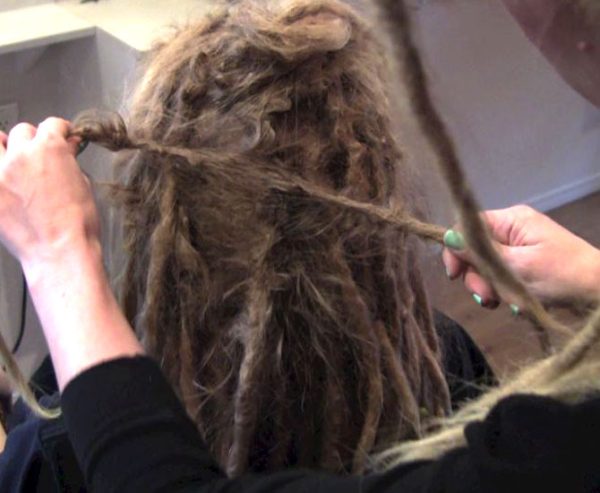
Due to their unique look and rich cultural heritage, dreadlocks have come to represent individualism and self-expression for a large number of people. There is a need to focus on the importance of attention to detail and diligence in maintaining dreadlock hair, specifically detangling. This blog post offers tips and methods to achieve the best possible appearance of dreadlocks.
Understanding The Tangles
Dreadlocks tangle due to new growth, friction from daily activities like sleeping, wearing hats, or rubbing your head against objects, and dehydration, which increases the risk of tangling and breakage. Understanding these factors is important before detangling dreadlocks.
Tools Used To Detangle Dreadlock Hair
Getting the appropriate tools is crucial before attempting to detangle dreadlock hair. It is necessary to use a wide-tooth comb or dreadlock comb to gently and damage-free separate tangled strands. In addition, a leave-in conditioner or a spray bottle full of water can assist soften hair and facilitate detangling.
Step-by-Step Detangling Process
Detangling dreadlock hair is essential for preventing breakage, promoting healthy growth, and maintaining the integrity of the locks. Here are some steps to take to help make the detangling process easier.
Start with wet Hair
After giving your hair a good wash, start the detangling procedure with wet hair. Wetting the hair lowers the chance of breakage while detangling by softening the strands.
Use the detangling product
To assist in lubricating the strands and lessen friction, mist the hair with water or use a leave-in conditioner. To guarantee even dispersion, run your fingers through the hair as you work the product in.
Apply Light Pressure
Working your way up toward the roots of the dreadlocks, start detangling at their tips. Using your fingers or a wide-tooth comb, carefully work through any knots or tangles with mild pressure and patience.
Split into portions
To make detangling more manageable, split the dreadlocks into smaller portions for more difficult knots or tangles. Before going on to the next stage, concentrate on detangling each strand as you work one at a time.
Take Breaks
Detangling dreadlocks can take a lot of time, so don’t be afraid to take pauses when necessary. By doing this, you’ll be able to avoid becoming tired or frustrated and tackle the task with composure and clarity.
Above all, having patience is essential while detangling dreadlocks. Hurrying the procedure or applying too much force may cause the hair to break and get damaged. Take your time, be nice, and have an optimistic outlook when detangling.
Preventive Measures Against Future Tangles
Make routine maintenance sessions with a professional loctician, use protective styles like braids or updos to reduce friction, and refrain from over-manipulating or using styling products to prevent recurrent tangles and knots in dreadlock hair. Your dreadlocks can stay tighter and more manageable with routine detangling and maintenance visits. Also, Reducing the amount of manipulation and styling agents used can aid in avoiding tangling and accumulation.
Frequently Asked Questions And Answers About Detangle Dreadlock Hair
1. How do I detangle my dreadlocks without causing damage?
To detangle dreadlock hair without causing damage, it’s essential to use gentle techniques and suitable tools. Start by finger detangling, gently separating knots and tangles with your fingers. If necessary, use a wide-tooth comb or detangling spray to further loosen knots, working from the tips towards the roots.
2. How often should I detangle my dreadlocks?
The frequency of detangling dreadlocks depends on various factors, including hair type, length, and maintenance routine. Generally, it’s recommended to detangle dreadlocks as needed to prevent excessive matting and tangling. Some people may detangle their locks weekly, while others may do so less frequently.
3. Can I detangle my dreadlocks when they are wet or dry?
Detangling dreadlocks can be done when the hair is wet or dry, depending on personal preference and hair type. Wet hair may be more pliable and easier to detangle, while dry hair may require additional moisture from a detangling spray or conditioner to loosen knots effectively.
4. What tools should I use to detangle my dreadlocks?
Suitable tools for detangling dreadlocks include your fingers, a wide-tooth comb, and a detangling spray or conditioner. Finger detangling is gentle and effective for smaller knots, while a wide-tooth comb can help loosen larger tangles. Detangling sprays or conditioners can provide additional moisture and slip to aid in the detangling process.
5. How long does it take to detangle dreadlock hair?
The time it takes to detangle dreadlock hair varies depending on the severity of the knots and tangles, as well as the length and thickness of the hair. Some detangling sessions may take only a few minutes, while others may require more time and patience.
6. Are there any techniques to prevent future tangles in dreadlock hair?
Yes, several techniques can help prevent future tangles in dreadlock hair. Regular maintenance appointments with a professional loctician can keep your locks tidy and prevent excessive matting. Additionally, protective styling, such as updos or braids, can minimize friction and reduce the likelihood of knots and tangles.
7. What should I do if I encounter a particularly stubborn knot or tangle?
If you encounter a stubborn knot or tangle while detangling your dreadlocks, take your time and be patient. Use gentle pressure and try applying a detangling spray or conditioner to help loosen the knot. If necessary, seek assistance from a professional loctician to safely and effectively remove the knot without causing damage to your hair.
Conclusion
Detangling dreadlock hair is an essential aspect of maintaining healthy, vibrant locks. You can maintain the integrity and beauty of your dreadlocks while keeping them at their best by employing gentle procedures, appropriate tools, and routine care. Recall to be persistent and patient, and don’t be afraid to ask for help from professionals if you need it.

Leave a Reply